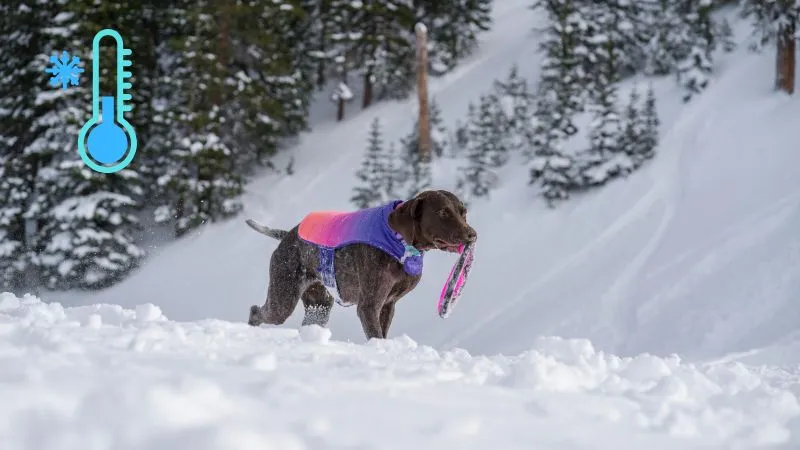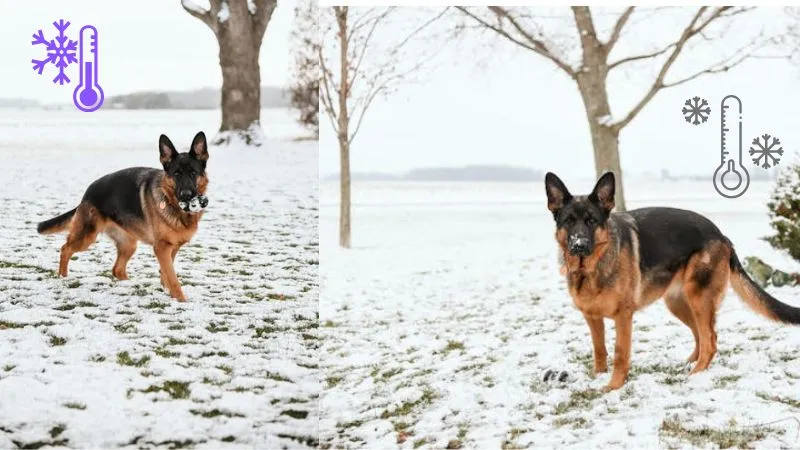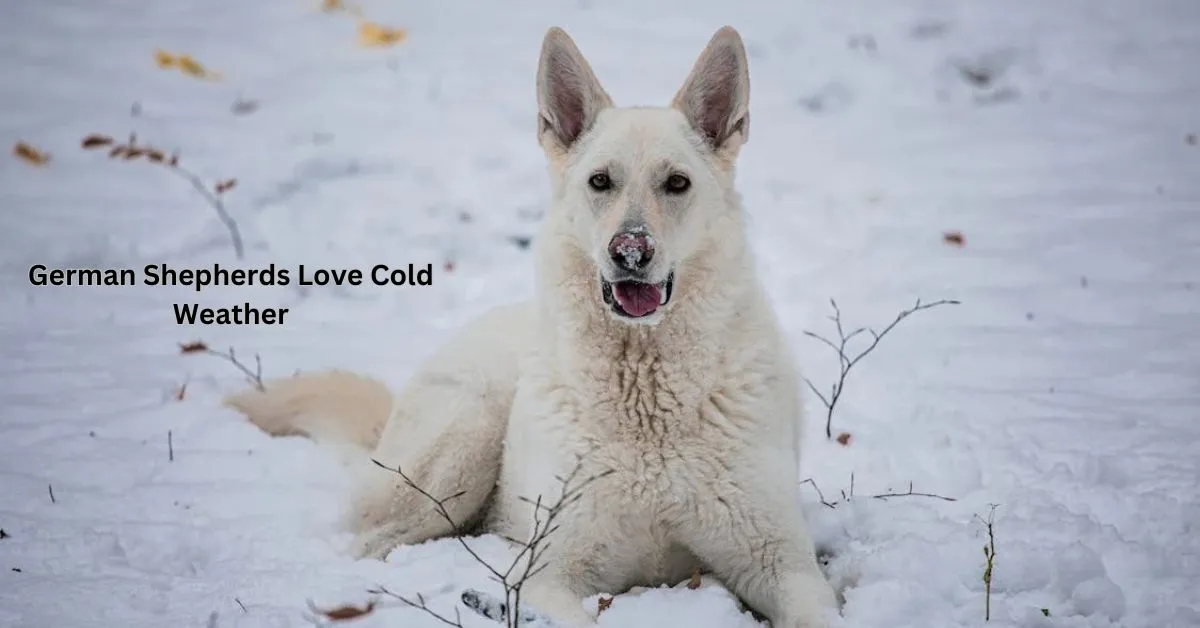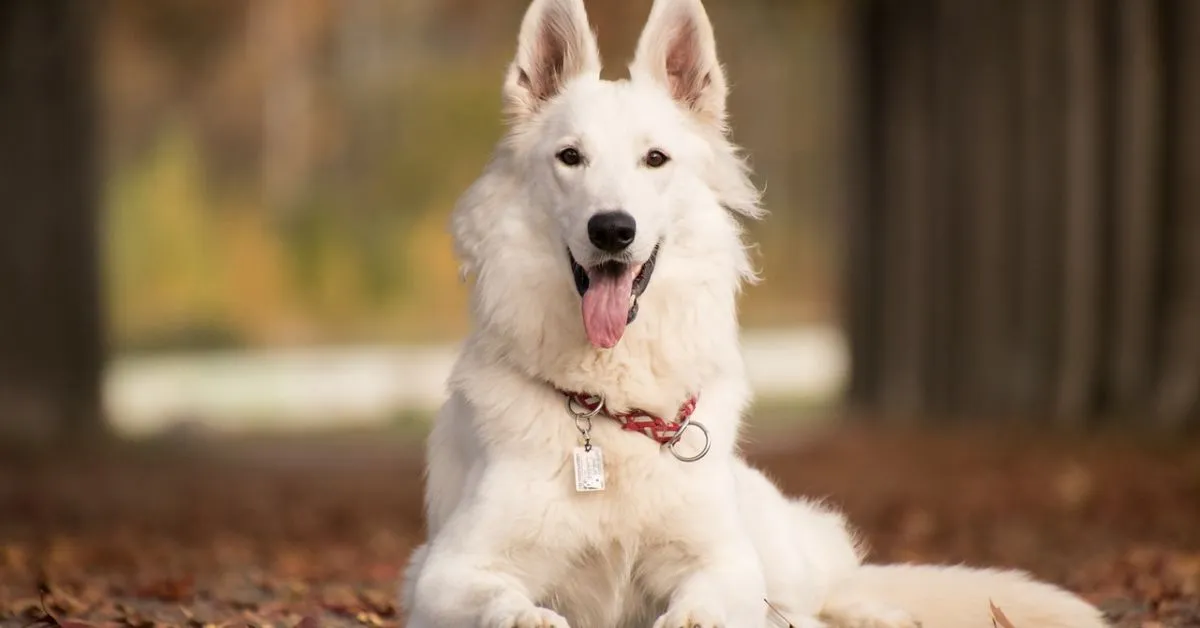German Shepherds are not just remarkable companions; they love cold weather and thrive in it. With their thick double coats and high energy levels, these loyal dogs enjoy playing in the snow and exploring frosty landscapes.
The cold not only keeps them comfortable but also provides opportunities for fun activities like running, playing fetch, and training sessions in the crisp air. In this article, we’ll explore why German Shepherds love cold weather and how you can make the most of winter with your furry friend.
How do I know if my German Shepherd is cold?
Close observation of their behavior is key to determining if your German Shepherd is feeling cold. Noticeable signs like shivering, whining, or whimpering can indicate discomfort due to cold temperatures. If your dog appears lethargic or refuses to go outside, it might be trying to avoid the cold.
Ensuring warmth is essential to allow them to bask in the sun when possible, or provide a cozy spot inside with a warm blanket or coat. Ignoring these signs might lead to negative health consequences over time, as freezing temperatures can cause significant stress and potential damage. By monitoring these behaviors, you can help keep your German Shepherd comfortable and safe throughout its lifetime.
What temperature is too cold for a German Shepherd?
When considering what temperature is too cold for a German Shepherd, it’s important to recognize that temperatures ranging from 0-45°F (-18 to 7°C) can potentially cause discomfort and health issues for these dogs. While German Shepherds are well-equipped for colder climates thanks to their double coat, extreme cold can still pose risks.
Observing your dog’s behavior is crucial; signs of discomfort, such as reluctance to spend time outside, shivering, or seeking warmer areas, may indicate it’s too cold for them. During particularly cold winters, investing in proper winter gear like coats or sweaters can provide additional warmth.
Although large breeds like German Shepherds may tolerate cooler temperatures better than smaller breeds, they should still not be left outdoors in extremely cold weather for extended periods, as this can lead to discomfort and health complications.
What temperature is too cold for a German Shepherd puppy?
German Shepherd puppies are more sensitive to extreme temperatures compared to adult German Shepherds. While adult dogs might tolerate temperatures as low as 32-50°F (0 to 10°C) without discomfort, puppies can become uncomfortable at these temperatures. Their bodies are not yet fully developed, making them more susceptible to the risks of hypothermia and frostbite.
Lower temperatures can have catastrophic consequences on a weak developing body, especially during cold winters. To protect these young pups, extra care should be taken to limit their exposure to cold temperatures. Allow them to go outside for short periods and multiple times rather than a single, extended outing.
Pay close attention to increasing outdoor temperatures before letting them play outside for longer periods. Ensuring a safe and warm environment will support their health and growth during these vulnerable months.
German Shepherd, Coat, and Cold Weather Resilience

German Shepherds are recognised bordely ized for their exceptional capability to. Withstand cold weather, a critical factor attributed to their unique double coat. This breed’s coat consists of a dense outer layer that protects against harsh environmental elements, complemented by a softer undercoat that offers insulation and warmth.
Naturally equipped for colder climates, these dogs benefit from a specialized coat structure that responds to dropping temperatures. As winter approaches, their undercoat thickens, enhancing their protection against the cold.
This natural adaptation allows German Shepherds to thrive in cooler temperatures while maintaining their health and comfort. Regular grooming helps maintain their coat’s effectiveness, ensuring that these loyal companions remain ready for the challenges of winter weather.
German Shepherd Winter Walks: Potential Risks and Precautions
Walking your German Shepherd in the winter can be a delightful activity, but it’s important to consider potential risks and necessary precautions. In temperatures ranging from 32-45°F (0 to 7°C), German Shepherds are generally comfortable, making it a safe range for short outdoor excursions.
However, wind chill can significantly affect these temperatures, making it feel colder than it is. Therefore, it’s advisable to limit walks to about 20 minutes during particularly cold days to avoid discomfort and mitigate health risks. Pay attention to your dog’s behavior during these winter months; signs of discomfort may indicate the cold is affecting them more than expected.
Although German Shepherds typically tolerate low temperatures well, each dog’s tolerance varies, and if your pet appears uncomfortable, it’s best to head indoors. Always ensure their paws are protected, and consider other winter gear to keep them warm while enjoying the frosty outdoors.
Why are German Shepherds an excellent breed for cold weather?

German Shepherds as Cold Weather Champions:
Among the best breeds for cold weather, German Shepherds excel due to their thick double coats, which provide excellent insulation and keep them warm even in chilly temperatures.
Intelligence and Working Drive:
Known for their strong working drive and intelligence, German Shepherds are adept at tracking and hunting, making them well-suited for activities in the snow.
Healthy and Robust Breed:
With a healthy breed body structure, German Shepherds thrive in cold climates, where their strong muscles and active nature allow them to perform well.
Ancient Breed with Resilient History:
Originating from Germany in the 19th century, they were bred as hard-working dogs capable of enduring challenging weather conditions like low temperatures, rainy days, and heavy snow.
Double Coat for Weather Protection:
Their double coat consists of a thick, coarse, and water-resistant topcoat along with a soft, dense, and insulating undercoat, keeping them warm and comfortable on cold days.
Medium-sized Breed Dimensions:
This breed is medium-sized, with males typically standing at 24 inches in height and females at 22 inches. Their strong, muscular build enables them to move quickly and efficiently.
Activity and Fitness in Cold Weather:
Known for their high activity level, they remain healthy and fit by running and exercising in cold, snowy conditions, ensuring they stay happy.
Adaptations for Winter Terrain:
Their fur-covered feet act like snowshoes, providing good blood circulation to their paws and helping them navigate on slippery surfaces, preventing slipping.
How do German Shepherds handle the cold weather?
Breeds Adapted to Cold Climates:
Certain dog breeds have been historically bred for cold climates, making them well-suited to handle and tolerate extremely cold weather.
Examples of Cold Climate Breeds:
German Shepherds, Siberian Huskies, Chow Chows, Alaskan Malamutes, Samoyeds, and Japanese Akitas are prime examples of breeds adapted to endure colder temperatures.
Thick Double Coats for Protection:
These breeds possess thick double coats that effectively regulate body temperature, keeping them warm during extreme cold.
Fur Density and Natural Insulation:
Their dense fur protects against harsh elements by providing natural insulation, which is essential for temperature regulation.
Innate Temperature Regulation Ability:
Equipped with an innate ability to handle colder temperatures, these dogs can maintain warmth due to their specialized coats.
Higher Metabolism for Heat Generation:
Many of these breeds have a higher metabolism, enabling them to generate additional heat to combat chillier air.
Wintertime Climates Adaptation:
Adapted to wintertime climates, these dogs thrive in cooler areas due to their cold climate breeding history.
Bred for Cold Climate Living and Working:
Historically bred for living and working in cold conditions, these breeds have inherently adapted to thrive in such environments.
Background and Bloodline History:
The background and bloodline of cold climate breeds showcase their remarkable ability to handle colder temperatures over time.
10 ways to keep your German Shepherd warm in the cold weather

Insulated Shelter:
Ensure your German Shepherd has a well-insulated house or shelter to protect against cold weather elements. Consider adding extra insulation or underfloor heating to their doghouse if they spend time outdoors.
Cozy Bedding:
Equip their shelter with warm bedding, such as blankets, cushions, and soft dog beds, complete with removable and washable covers. These items will help keep them cozy during winter nights.
Durable Materials:
Utilize durable, soft materials for their bedding to enhance warmth and comfort. Rubberized flooring can help insulate their feet from the cold ground, shielding them from cold drafts and open windows.
Enclosed Space:
Create a small, enclosed space in your home that’s well-insulated, and filled with pillows and towels, to provide a warm refuge away from cold air.
Sunny Spots:
Encourage your dog to utilize sunny spots in the house to naturally regulate their body temperature, making the most of warmer areas during the day.
Daily Exercise:
Engage your German Shepherd in regular exercise like short walks to help boost their metabolism and generate body heat necessary during cooler periods.
Feeding Adjustments:
Adjust their diet as needed, ensuring they have ample nutrition to help generate heat.
Coat Maintenance:
Keep their coat dry, clean, and brushed to maintain its insulation properties, and prevent discomfort from wet or dirty fur.
Monitor Outdoor Time:
Vigilantly monitor the time your dog spends outdoors, especially in extremely low temperatures, and be ready to bring them inside if necessary.
Mind Frigid Conditions:
In frigid temperatures, reduce outdoor time significantly and prioritize indoor activities to keep them warm and comfortable.
Do German Shepherds like cold or hot weather?
German Shepherds are not well-adapted to hot climates due to their thick coats, which can make it difficult for them to regulate their body temperatures in intense heat. During extremely hot days, they may become listless and seek out shady resting spots.
These intelligent dogs will often dig shallow holes in the ground, providing a cool respite from the sun. It’s important to ensure that they have access to plenty of water and cool areas to prevent overheating and maintain their well-being.
Is it possible for German Shepherds to live outdoors during the winter?
German Shepherds can live outside during winter, but it requires ensuring they have a warm and insulated shelter to protect against cold weather elements. Their thick double coat provides some natural insulation; however, as temperatures drop below freezing 32°F (0°C), additional measures are necessary to keep them comfortable.
A sturdy shelter should provide a dry, windproof environment with fresh water available at all times, as hydration is crucial even in cold months. While German Shepherds are relatively hardy and can handle cold to an extent, it is advisable to bring them inside during severe weather conditions.
When temperatures fall significantly below freezing or during heavy snow, rain, or strong winds, these dogs are at risk for hypothermia and frostbite. Offering a warmer indoor environment during these harsh conditions is the best course of action to safeguard their health and well-being.
Maintaining the Balance Between Activity Levels and Cold Weather
German Shepherds are high-energy dogs that require regular exercise to maintain their health and well-being. In colder climates, owners need to maintain their dog’s exercise routine while being mindful of temperature extremes.
Owners should carefully monitor their dogs for any signs of discomfort or cold stress during outdoor activities. Adjusting the duration and intensity of exercise based on weather conditions is crucial, ensuring that the dog stays active without risking its health.
Nutritional Needs in the Cold: Fuel for Warmth

Nutrition is crucial for helping German Shepherds tolerate cold weather, especially during winter months. These dogs require more calories to maintain their energy levels and body heat. Feeding them high-quality, protein-rich diets provides the necessary energy but owners should avoid overfeeding to prevent excessive weight gain and related health problems.
Health Considerations in Cold Climates: Prevention and Care
Cold weather can exacerbate health conditions in German Shepherds, such as arthritis. Owners must be vigilant about their dog’s health and comfort by providing warm bedding and avoiding prolonged exposure to freezing temperatures. Regular veterinary check-ups are essential to ensure any health issues are addressed promptly.
Winter Grooming and Skin Care: Safeguarding Their Coat
Proper grooming is essential for maintaining the health and insulation properties of a German Shepherd’s coat. Regular brushing helps remove dead fur and keeps the skin healthy by distributing natural oils throughout the coat. Bathing should be limited during winter to avoid stripping the coat’s natural oils, which are crucial for maintaining skin and coat health.
The Significance of Adequate Shelter: Warm Havens in Cold Weather
While German Shepherds can tolerate cold weather, having a safe, warm shelter is vital. Outdoor dogs should have access to a well-insulated dog house that protects them from wind, rain, and snow. Indoor dogs need a warm, cozy spot away from drafts where they can rest and sleep comfortably.
Training and Adjustment: Getting Ready for Cold Weather
Training and gradual exposure can help German Shepherds adapt to colder climates. Introducing cold weather gradually through positive experiences, such as playing in the snow, can help them adjust. Equipping them with protective gear like coats and booties provides added warmth and protection in extreme conditions.
The essential gear for German Shepherds throughout the winter
Winter Coat:
Invest in a high-quality winter coat to keep your pup’s fur dry and insulated against cold temperatures. This essential item helps maintain body heat while shielding the coat from moisture.
Booties:
Protect your dog’s paws from cold and icy surfaces. Booties are crucial for keeping your pup comfortable and preventing injuries during winter walks.
Boot Socks:
These can be worn with booties to help keep your dog’s feet warm and protected from snow and ice. They add an extra layer of insulation.
Sweaters:
On particularly cold days and evenings, sweaters can provide additional warmth for your German Shepherd, ensuring they stay cozy both indoors and outdoors.
Paw Balm:
Use a paw balm to protect your pup’s paws from the elements, keeping them moisturized and preventing cracks and injuries.
Safety LED Collar:
Enhance your dog’s visibility during dark and snowy days with a safety LED collar, ensuring they can be seen and remain safe during walks.
Common Misconceptions
German Shepherds are renowned for their adaptability and resilience, but there are common misconceptions about their ability to cope with winter months. Many people believe these remarkable dogs can effortlessly handle the cold; however, it’s crucial to debunk these myths for an accurate understanding.
While their double coat provides some protection, German Shepherds still need appropriate care and consideration to ensure their well-being during chilly seasons. Addressing these misunderstandings and dispelling inaccurate beliefs can help owners navigate the winter months effectively, ensuring their dogs stay safe and comfortable.
Misconception 1: German Shepherds Are Naturally Cold-Resistant
A popular belief is that German Shepherds are naturally cold-resistant due to their double coat, which provides insulation. However, these dogs can still feel cold, and their tolerance to cold temperatures can vary depending on factors such as age, health, and coat condition.
Misconception 2: They Don’t Need Extra Warmth
Some believe that German Shepherds don’t need extra warmth in cold weather. In reality, during extreme cold, they benefit from additional protection such as coats and sweaters, especially puppies, seniors, or those with thin coats.
Misconception 3: They Can Stay Outside in Freezing Temperatures
It’s a misconception that German Shepherds can stay outside in freezing temperatures. These social animals thrive on human interaction and can suffer hypothermia or frostbite if exposed to severe colds without proper shelter and insulation.
Misconception 4: Their Thick Fur Alone Is Sufficient
While German Shepherds have a thick double coat, it’s not invincible. When wet, it can reduce insulation, making them feel chilly in harsh winter conditions.
Misconception 5: They Don’t Need Exercise in Winter
Some may neglect a German Shepherd’s need for exercise in winter. As an active breed, they require regular exercise, and neglecting this can lead to weight gain and behavioral issues. Owners should find safe ways to keep them active even in the cold.
Misconception 6: They Can Eat More in Winter to Stay Warm
It’s an error to think that German Shepherds can simply eat more in winter to stay warm. Overfeeding can result in weight gain and health problems. A balanced diet should be maintained according to their activity level, and their weight monitored.
Misconception 7: Cold Weather Will Toughen Them Up
The notion that cold weather will toughen up German Shepherds is misleading. Exposing them to severe conditions can lead to health issues like frostbite and hypothermia. Prioritizing their well-being over toughening them up is crucial.
Misconception 8: They Don’t Need Water in Winter
The belief that German Shepherds don’t need water in winter is incorrect. Proper hydration is crucial year-round, and dehydration can occur even when they are active outdoors in the cold.
Misconception 9: They Should Be Bathed Less in Winter
It’s a misconception that German Shepherds should be bathed less in winter. Regular grooming is essential, as dirty or matted fur can reduce insulation and cause skin issues. Maintaining the coat’s insulating properties through appropriate grooming is important.
Misconception 10: German Shepherds Love Snow All the Time
While many German Shepherds enjoy playing in the snow, not all dogs have a high tolerance for cold and may dislike wet conditions. It’s important to observe each dog’s comfort level rather than assume they love snow unconditionally.
By dispelling these common misconceptions, German Shepherd owners can better understand their pets’ needs during the winter months and provide them with the care and attention necessary to keep them safe and comfortable in colder weather.
Final words
German Shepherds are indeed one of the more durable dog breeds, capable of enduring bad weather conditions longer than most dogs. However, this doesn’t mean they should be left to withstand adverse weather impacts without care. As an owner, it is best practice to find a balance between keeping them inside the house and allowing outdoor time when weather conditions are not ideal.
It is advised to always let them have a space just for themselves equipped with a big, comfortable dog bed, multiple pillows, a floor mat, a warm blanket, or even a large crate to make them feel as at home as possible.
In this way, you can protect them from inclement weather conditions while ensuring their comfort upon return indoors. Providing a cozy retreat underscores the endless love and friendship you share with your pet and reminds you to cherish the rest of your life together.
FAQs
How cold is too cold for your German Shepherd?
German Shepherds are resilient to cold weather, but temperatures below 20°F (-6°C) can be too harsh, potentially leading to hypothermia.
Can German Shepherds sleep out in the cold?
While they can handle cool temperatures, it’s crucial to provide adequate shelter, especially during extreme cold.
How to keep a German Shepherd warm in winter?
Ensure they have a well-insulated shelter, extra bedding, and sufficient nutrition to maintain body heat.
Do German Shepherds like the heat?
They tolerate heat moderately well but must have access to shade and water in hot weather to prevent overheating.



